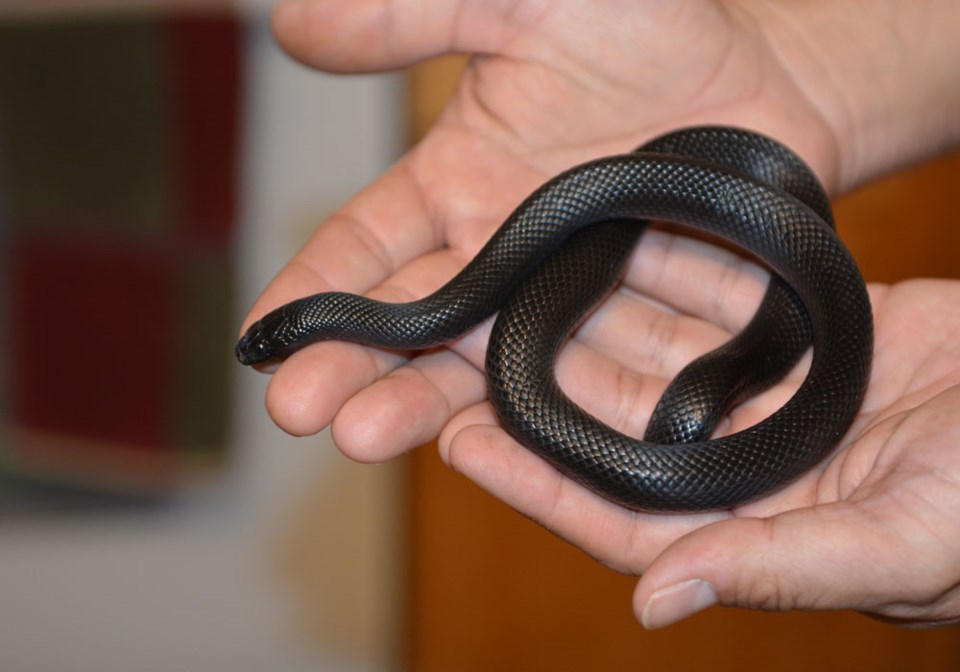Matt Olson’s cat led him to the discovery of a rare snake that had somehow found its way into the basement of his Third Street home last Tuesday.
The snake, cat and Olson are just fine and the Royal Saskatchewan Museum now has a new species to trot out for their field trips and their upcoming Biology Field Day that they will be conducting at the museum on July 28, starting at 1 p.m.
“Pepe will join our display of other snakes like the bull snake and hognosed snake we have here,” said Ray Poulin, head of research and collections and curator of the vertebrate zoology section at the museum, noting their newest addition now has a pet name.
What Olson and his cat discovered was a non-native snake to Saskatchewan, a Mexican black kingsnake, common to the desert region of that country, certainly not Saskatchewan.
“This snake would have a hard time living on its own around here,” said Poulin, who sent a student intern to Estevan to retrieve the snake following a conversation with Olson. “It’s pretty hard being a snake in Saskatchewan. We only have nine species and eight of them can only survive effectively in the southern half of the province,” said Poulin.
The Mexican black kingsnake is not dangerous and is more commonly found within the pet trade. Poulin suggested this is probably what Pepe was at one time.
“I expect he either escaped or was let loose by a previous owner,” said Poulin.
Olson said that prior to releasing the snake into the valley south of the city, he had contacted the local veterinary clinic and the Estevan Humane Society to see if anyone had contacted them regarding the black snake.
But shortly after speaking with Poulin, who persuaded him to go look for the snake and take him back into captivity, Olson re-visited the area in which he had released the snake, and found it. So he placed it in a pail and waited for the museum intern.
“It wasn’t in very good condition when we got him, but it’s just fine now,” said Poulin.
Owning this type of snake is allowable, so whomever had him, was not breaking any law. Pepe is quite docile.
“The only venomous snakes we have in Saskatchewan are rattlers,” said Poulin.
And really, the only other strange characteristic about the Mexican black kingsnakes, besides the colour, is the fact they are known to be able to consume other snakes, including rattlers, and are unaffected by the rattlesnake’s venom. They also dine on mice and other obvious prey. “Yes, in the wild, the kingsnake can hunt down other snakes for a snack,” said Poulin.
Pepe is now about 18 inches in length, which is considered a medium size and will grow up to four feet.
“We will use him for educational seminars with students and such things like the upcoming field day,” said Poulin.
Keeping Pepe in the museum’s fold will ensure the Prairie eco-system is not disrupted, at least not in the snake world. Poulin said recent discoveries of red-eared turtles in Regina’s Wascana Park may lead to some disruptions of the eco-system enjoyed by the indigenous painted turtles common to southeast Saskatchewan. The red-eared turtles are often brought home as pets and then later released by owners who either get bored with them, see them as a nuisance, or just can’t cope with them as they get bigger with age. Turtles will live for 30 to 50 years under good conditions.
“Because of our climate, Saskatchewan has a reset button,” said Poulin, referring to winter, which often separates the non-native species from those who have to adapt or die.
His snake research has meant Poulin receives several phone calls every month regarding the slithery invertebrates. Olson’s call back in May, while not about an ordinary subject, certainly wasn’t surprising, but still, rather interesting.
“I was in Ontario at the time we got his call, but I really wanted him to retrieve the snake, so we could have him to study,” said Poulin.
As for the cat, well, Olson said “my cat was just freaking out on me after I got home from work that day and kept focusing on the stairwell into the basement of our older home. I checked down the stairs, and at first I thought ‘who the heck left an electrical cord on the stairway,’ then the cord moved,” he said with a laugh. “I’m just a prairie farm boy, the only thing I knew about were garter snakes, so this thing was pretty strange and I wasn’t about to pick it up. I got a shovel and put it in a pail. I thought for a moment I should just kill it, but I couldn’t do that.”
After calling the vet clinic and Humane Society, Olson figured the best thing to do would be to release the snake in a more natural environment. “I took it to the valley and then ended up going back and picking it up again after talking with Ray.”
Olson said he also checked with people in the neighbourhood to make sure none of them were missing a slithery pet and he was relieved to learn that this snake was not aggressive when he went to pick it up with the shovel.
“So we have named him Pepe, after that skunk in the old cartoons, and he’s really a pretty impressive snake with that glistening black colour, even his eyes are black,” said Poulin. “He’ll probably have a long and healthy life here with us. Snakes can live 15 to 20 years or more, Pepe will be fine.”



